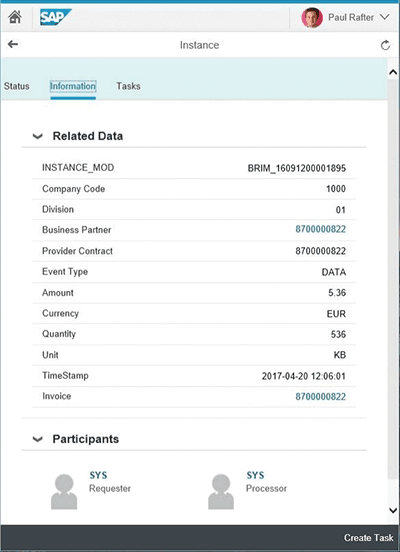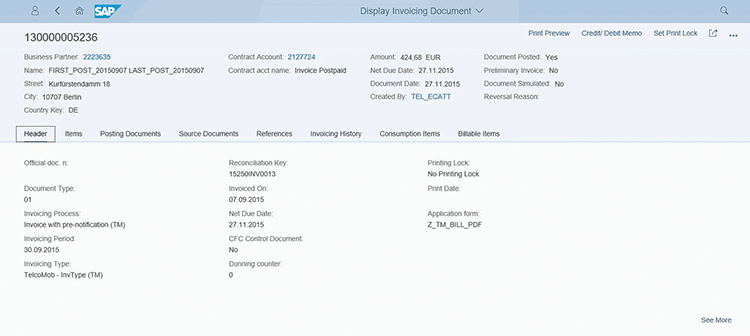Optimized Billing with Process Intelligence
How to Use SAP Operational Process Intelligence with SAP Hybris Billing to Enable Real-Time Insight
It’s no revelation that digital technologies have changed both customer expectations and the way that businesses meet those expectations and monetize customer interactions. Customers expect a fast, easy, and engaging interaction — a simple click to “subscribe,” “download now,” or “send” via MMS. For the business, these clicks represent revenue, particularly for those transitioning to a digital business model based on innovative service and product combinations that often involve revenue sharing agreements with partners.
From the business perspective, there is much more at play behind the scenes than that simple click — this customer action triggers an end-to-end process that involves multiple networks, ordering systems, rating systems, pre-invoicing, invoicing, receivables, payables, and collections. If everything is perfectly aligned, a single event record must traverse this expansive process before ending up as a fully settled transaction. If something goes wrong — especially when it comes to billing — the event may fail to be fully processed, potentially resulting in an unhappy customer and loss of revenue.
So how can you minimize this risk? To help, SAP provides SAP Operational Process Intelligence, an SAP HANA-based solution that delivers real-time insight into processes across your landscape, enabling you to improve process performance and address potential problems before they can harm your business. This article looks at a use case for this solution that is common — and critical — for any organization operating in the digital economy: the billing process. We’ll examine how SAP Operational Process Intelligence can be used with SAP Hybris Billing to ensure a reliable back-end process and a front-end experience that meets modern customer expectations.
Explore related questions
Billing in the Digital Economy
Billing plays a critical role in customer engagement. Invoices often represent a primary point of contact with the customer, and a smooth invoicing process paves the way to prompt payment and a satisfied customer. Any issues with billing and invoicing, however, can quickly set up a cycle of phone calls, emails, and complaints to customer service and can drive down customer satisfaction. In fact, in many companies, invoicing issues represent a predominant source of customer interaction volume, which can prove costly, especially in a digital economy where margins are tight, customers demand speed and simplicity, and competitors are only a click away.
To lower costs, reduce risks, and increase customer retention and revenue, many SAP customers depend on SAP Hybris Billing to manage their invoice and billing processes. SAP Hybris Billing provides a comprehensive set of functionalities — including subscription order management, flexible pricing, automated billing, converged invoicing, and personalized payments handling — to streamline the management of these processes and help organizations succeed in a digital business model. It is also designed to be adaptable to the varying needs of individual organizations, with customizable implementation options that result in a wide array of unique processes that incorporate a variety of systems and applications.
In response to SAP Hybris Billing customers’ requests for a way to gain greater visibility into their unique end-to-end processes — and to provide them with the confidence that they are meeting their own customers’ expectations while driving revenue growth — the SAP Hybris Billing product team turned to SAP Operational Process Intelligence, which is ideally suited to this task. Through its user-friendly workspace interface and use of SAP HANA, it provides near-real-time visibility into cross-application, cross-technology business processes and scales to support the high volumes of events that SAP Hybris Billing customers must be able to process in the digital economy.
In 2015, the SAP Hybris Billing product team, with the help of key consulting resources, started working with SAP Operational Process Intelligence with the simple goal of creating a working prototype that would follow every single customer usage transaction in SAP Hybris Billing, from the time of the initial click all the way through to the collections process. The result is a working proof of concept and “cookbook” that companies can use to ease the setup and implementation of their own SAP Hybris Billing scenario.
The end-to-end view enabled by SAP Operational Process Intelligence provides SAP Hybris Billing customers with a single place to gauge the health of the overall billing process. Additionally, users can monitor cycle times between various billing phases, ensuring service level agreement (SLA) compliance while identifying and correcting errors before they have the chance to adversely affect revenue. The ability to take action in advance can help prevent billing-related customer dissatisfaction.
When SAP presented the prototype to SAP Hybris Billing customers, the reactions were overwhelmingly positive and each customer began thinking about how they could best model their unique billing processes in SAP Operational Process Intelligence (see the sidebar for more on enabling this scenario). Let’s explore some of the key capabilities of this combined implementation, and how it can improve the billing process in your own organization.
Gaining Insight with SAP Operational Process Intelligence
Through its customizable process modeling capabilities, SAP Operational Process Intelligence can provide both a high-level view of the overall SAP Hybris Billing process and in-depth insight into the details of this particular process, which allows the user to quickly isolate an issue for resolution.
Together, these perspectives help key process stakeholders — such as the billing operations manager and the customer service team — gain the insight they need to resolve problems that can cause delayed revenue or a negative customer experience.
A High-Level Overview of the Billing Process
Figure 1 shows the main cockpit view of the SAP Hybris Billing prototype within SAP Operational Process Intelligence. The cockpit provides a bird’s-eye view of the defined end-to-end process (in this case, a Consume-to-Cash process scenario defined for SAP Hybris Billing) and tracks open instances of the process (for this scenario, the instances are defined as the chargeable items or usage events that occur throughout the process) until they are paid across a variety of phases. The phases defined for this scenario, which are shown at the top of the cockpit, include:
- Event acquisition, where the initial usage activity occurs
- Rating, where an initial price is applied to the usage activity
- Billing, where priced events are grouped and aggregated to help speed processing
- Invoicing, where SAP Hybris Billing usage is processed further, including special invoice-level discounts
- Collections, where payments are applied and instances are closed
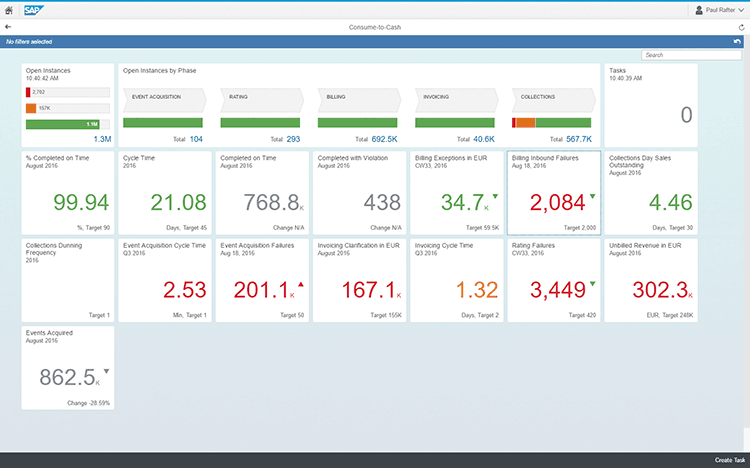
A variety of key performance indicators (KPIs) defined for this process scenario — such as completed on time, billing inbound failures, and invoicing cycle time, shown as tiles below the phases — track the health of the end-to-end process and the specific process steps based on user-defined thresholds that trigger alerts on any significant or emerging variances. The display can also be tailored to different user roles, so that you can provide users with the information that is relevant to them.
From the overview screen, users can drill down into the details to identify any potential problem areas. Let’s look at how these deeper insights can help two types of users that play central roles in the billing process: billing operations managers and the customer service team.
Insight for Billing Operations Managers
While the high-level view itself is useful for ensuring the health of the overall process, the ability to more closely examine each KPI for additional details about the cause and sources of any variances is where SAP Operational Process Intelligence provides significant value for billing operations managers.
Take the Billing Inbound Failures KPI shown in Figure 1, for example. This KPI looks at events as they pass from the rating phase, where pricing is applied, into the billing phase. SAP Hybris Billing checks a variety of event characteristics to ensure that the rated event is correct and ready for billing. Events that fail to pass this check are held until they are resolved. These events represent revenue and any that fail should be addressed immediately. With SAP Operational Process Intelligence, the billing operations manager can drill down into the KPI and change the view to suit the situation — change from a daily view to a monthly view, for example, or look at specific types of usage events to ensure things are progressing smoothly, as shown in Figure 2.
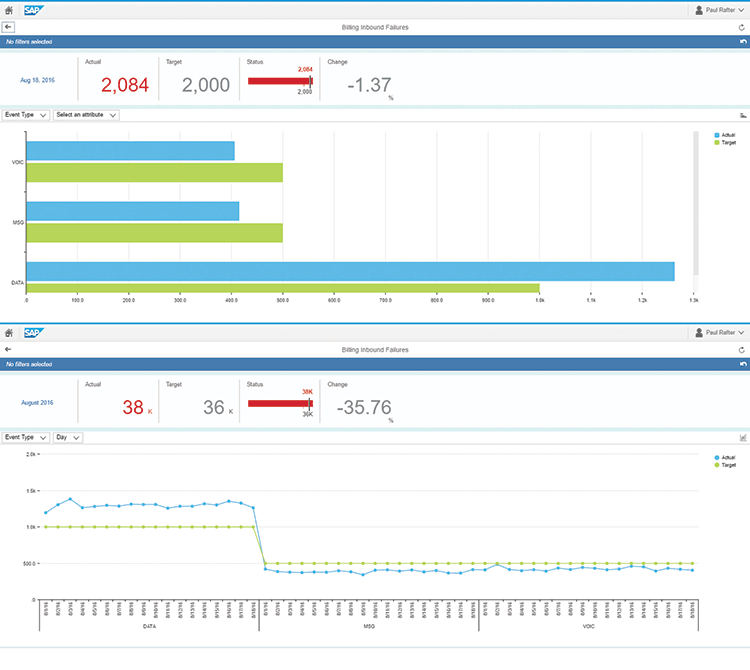
The billing operations manager discovers that for a specific event type (the DATA event type in the example), the KPI violates the threshold defined for the Billing Inbound Failures KPI. To address this issue, the billing operations manager creates a task instructing an “expert” on the team to follow up on the cause of this problem, and subscribes to an alert that will trigger an email when a negative change occurs and the KPI turns from green to yellow or red (see Figure 3). This close monitoring allows for a quick reaction, and the detailed information provided helps ensure that revenue is protected and minimizes the potential for revenue leakage.
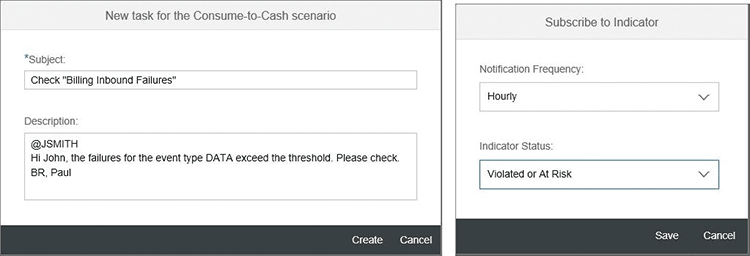
Insight for the Customer Service Team
In addition to providing insight to billing operations managers, SAP Operational Process Intelligence provides useful information to the customer service team — especially those who deal specifically with invoicing issues. These users can leverage the solution’s drilldown capabilities to quickly identify and isolate any billing issues that have the potential to affect customers to avoid a negative customer experience.
For example, the customer service billing agent may receive a call or email asking about the status of the latest invoice. With SAP Operational Process Intelligence, the agent can locate all the usage events for that customer that are still open or in process by entering the customer ID into the search field in the main cockpit view, which will display all the usage events (or instances) for that customer (see Figure 4).
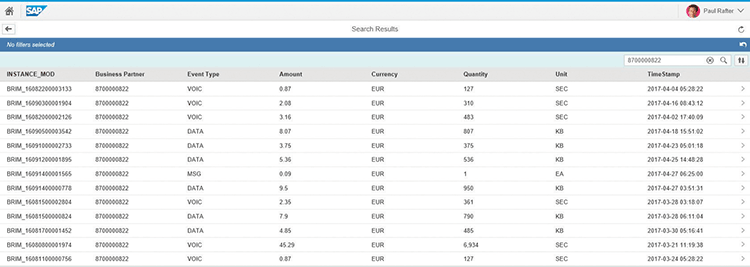
The agent can then drill down into a specific instance to look at issues by clicking on that instance, which displays the “milestone” view shown in Figure 5. At the bottom of this view, the agent can see that the event has the status “outsorted by invoicing,” which means predefined invoice checks have determined the amount to be higher or lower than expected, for example, requiring the agent to validate the amount prior to releasing the invoice.
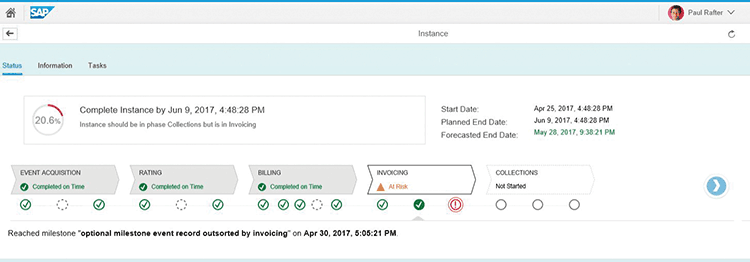
The billing agent can click on the Information tab at the top of the milestone view to see additional business information for the instance (see Figure 6). Clicking on the hyperlinked invoice number included in the business information displays the relevant invoicing document in the back-end system (see Figure 7).
With both search and drilldown capabilities, the billing process for a specific customer can be monitored end to end to ensure customer satisfaction.
